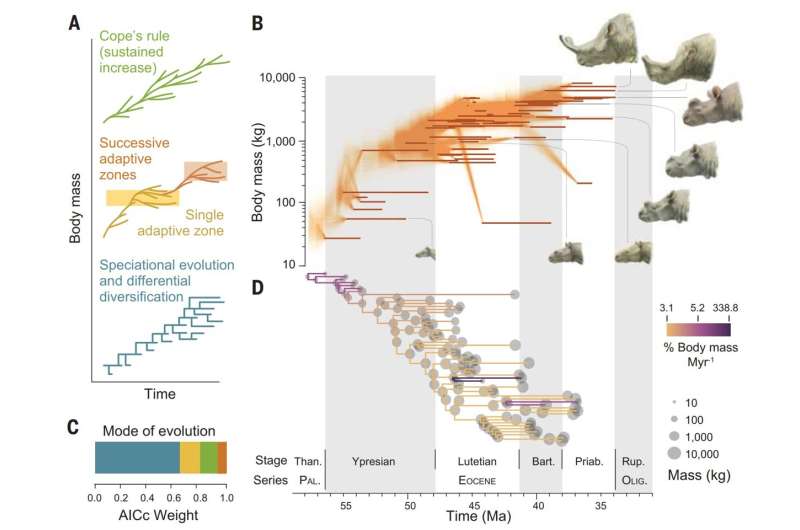May 12, 2023 report
This article has been reviewed according to Science X's editorial process and policies. Editors have highlighted the following attributes while ensuring the content's credibility:
fact-checked
peer-reviewed publication
trusted source
proofread
Study suggests differential species proliferation likely key to evolutionary increase in size of brontotheres

A pair of evolutionary ecologists from Universidad de Alcalá, working with a colleague from the New York Institute of Technology, reports that differential species proliferation was likely the key to the evolutionary increase in size of brontotheres. In their study, reported in the journal Science, Oscar Sanisidro, Juan Cantalapiedra and Matthew Mihlbachler studied the fossil record of the huge beasts and created computer simulations to show how they likely evolved.
In the late 1800s, zoologist Edward Drinker Cope developed a rule to describe the means by which animals evolve to grow larger in size, as many advantages tend to accrue to larger species. That rule, now known as Cope's rule, appears to apply to a large number of species, but sometimes, other factors may come into play that skirt the rule, promoting growth for other reasons. In this new effort, the researchers found that another factor was likely at play with the evolution of brontotheres—a family of extinct mammals that were known for their huge size, at least some of them. And that difference convinced the researchers that Cope's rule did not apply.
Prior to the Chicxulub impact, dinosaurs were the only large land-dwelling animals. After their demise, mammals began filling their niche, with brontotheres leading the way. Over just 16 million years, some grew from dog-sized creatures to rhinoceros-looking behemoths weighing more than a metric ton. In this new effort, Sanisidro, Cantalapiedra and Mihlbachler sought to learn more about the factors that allowed them to grow so quickly.
The researchers studied 276 brontothere fossils and created simulations based on their findings. They assumed that brontothere growth followed one of three scenarios—one followed Cope's rule, another cited adjustments to changing adaptive zones, and the third possibility was that some sort of speciational evolution had occurred without preferential direction.
After looking at their models and data, the researchers came to believe the most likely option was the third. They cite evidence showing that as time passed, some species of brontotheres grew smaller, some stayed about the same size and some grew larger. As more time passed, the larger species found more success and continued to get bigger, right up to the end of the Eocene epoch, when they went extinct, likely because of a changing climate.
More information: Oscar Sanisidro et al, A macroevolutionary pathway to megaherbivory, Science (2023). DOI: 10.1126/science.ade1833
Journal information: Science
© 2023 Science X Network




















